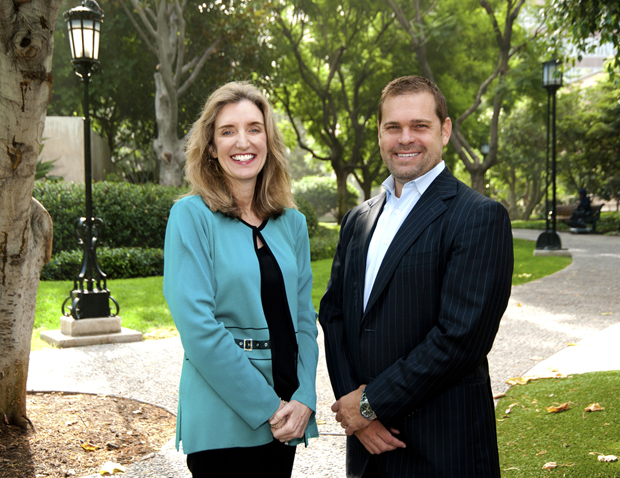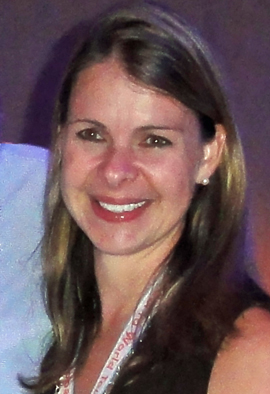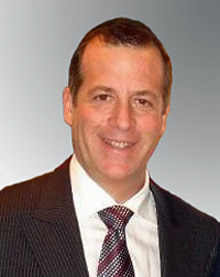| For the 8th consecutive year,
we are kicking off the New Year with our
annual State of the Industry Cover Story, an endeavor
that brings together experts and company
leaders from across the industry to get their
thoughts on the key trends of the past year and what
they believe is in store for the year ahead.
For 2012
we have gathered 15 well-known executives,
investors, developers and attorneys to share their
thoughts. As we do each year, we have assembled a
panel that features both esteemed experts who have
shared their wisdom with us in the past and new
contributors (a half dozen of them this time around)
that bring unique insights of their own.
We've divided our experts into three groups,
starting with domain sales & monetization
executives on this page, followed by domain
investors and developers on page
2, then a group representing three
different continents whose worldwide activities
(across all of the categories noted above) give a
global view of our industry on page
3. |

Image: Master
isolated images /
FreeDigitalPhotos.net |
|
The one constant in our business is change
and once again we saw plenty of that in 2011. One of
the major changes in the year just past was in the
executive suite at one of the industry's largest
companies, Oversee.net.
At the end of August President and CEO Jeff
Kupietzky resigned
with two executives, Debra Domeyer and
Scott Morrow, named to take his place as Co-Presidents.
As leaders of a conglomerate whose portfolio
includes such well-known subsidiaries as DomainSponsor.com,
SnapNames.com, Moniker.com and the DOMAINfest
Global conference, Debra and Scott are familiar
with every aspect of the domain business so we are
pleased to be able to kick off this year's article
by welcoming these first-time contributors to our
State of the Industry report.
|

Debra
Domeyer and Scott Morrow, Co-Presidents,
Oversee.net Rather
than answer our questions separately, Debra and Scott,
working as the team they are, drafted a joint
response to the two queries we posted, starting with what
they considered to be the most significant events and/or
trends in their category of the industry and in the
industry overall in 2011, then their outlook for 2012. Debra
Domeyer and Scott Morrow: The most significant
events in the domain parking space in 2011 were the
emergence of a new crop of competitors and the market
movement toward alternative monetization. Google’s decision to expand the number of companies
using its AdSense for domains feed resulted in a number of
new parking service providers entering the space.
With the continued focus on traffic quality, only publishers
with good quality traffic will see long-term benefit from
this increased competition.
With so many new parking competitors on
the scene, key differentiators are consolidation or
innovation. Our
opinion is that consolidation won’t be enough. In
today’s market, competitors, no matter their size, those
focusing solely on parking as a means to monetize domain
traffic, will be left behind.
Innovation is key.
That’s why we are focused on innovation in broader
areas including alternative monetization models, mobile
monetization, profiling, and semantic analysis.
| Oversee is building a diverse set of
monetization options and we are not alone in developing
alternative monetization options.
In 2011, other companies in the domain space
attempted to launch or expand their own alternative
monetization technologies.
Advertisers using |

|
| DOMAINSponsor’s PrecisionTargetingEngine
platform announced at DOMAINfest in February 2011 are
excited about their ability to directly obtain domain
traffic. They
want more. That’s
why we continue to invest in refining this platform.
Insights, innovation, critical mass, leadership and
healthy cash flow will be the keys to success in ensuring
that these technologies evolve into compelling solutions for
advertisers and publishers alike. |
In 2012, we expect many of the
new competitors in the parking space to begin facing
challenges associated with traffic quality, competitive
pricing pressures, and the increasing overhead costs
associated with meeting Google’s ongoing compliance
requirements, not to mention meeting increasing service and
technology demands of their clients.
The stresses and strains of these challenges will
likely produce some changes in the competitive landscape.
Some competitors may merge.
Some may be forced to cut back on service and
technology, others may simply go away.
As mentioned earlier, the real winners
will be those that innovate beyond domain parking to
find the optimal mix of monetization alternatives, from
parking/PPC to CPA/CPV/CPL.
But innovating won’t be easy.
It will take intimate knowledge of advertiser and
publisher needs in the performance marketing space, a
critical mass of quality traffic, strong technology
leadership, and healthy cash flow to be successful.
|

Image: scottchan
/ FreeDigitalPhotos.net |
Based on these keys to success, we
would argue that Oversee is in a very advantageous position
for a breakthrough year.
In 2012, we’ll be focused on improving
publisher and advertiser performance, specifically, through
continued optimization of our core parking platform,
expanding monetization options, improving traffic quality,
leveraging mobile and driving innovation.
First of all, we have gained tremendous
advertiser insights through our alternative monetization
platform. We
also continue to grow our owned and operated consumer
lead generation businesses in the travel, consumer
finance, and shopping verticals and our in development of
services in support of these
|
| efforts.
These businesses give us unique insights into
the world of performance marketing.
As a result, we know what kind of traffic advertisers
want, how they want to measure it, and how to get it. |
Secondly, we expect to see in 2012 an
increased focus on monetizing mobile traffic.
This is a large and growing segment that is
underserved by domain parking companies.
We are looking to be the leader in this area of the
domain industry. Oversee
is already well underway in developing both vastly improved
monetization solutions in addition to several exciting new
product initiatives in the support of our growing mobile
traffic. Stay
tuned!
Thanks to the millions of 3rd
party domains we monetize each month at DomainSponsor, we
have the quality traffic critical mass that advertisers are
looking for. And
with over 1 million domains in our own portfolio plus
the largest third party domain network, we certainly have a
strong vested interest in constantly trying to obtain
maximum RPMs for ourselves and our clients.
And finally, as pioneers that invented
the domain parking industry back in 2002, we know ad network
technology, how to design it, how to build it and how to
leverage it. We
are making large strides with our semantic analyzer
technology and are seeing very successful gains in our
optimization efforts. In
a nutshell, we have the volume, technology, and business
leadership skills needed to get it done.
Kathy
Nielsen,
Director, Strategic Alliances,
Sedo.com
|
Sedo Co-Founder and CEO Tim
Schumacher and Kathy Nielsen, then the company's
Director of Sales (North America) both contributed to last
year's State of the Industry report. In another
major change, Tim, a long time industry leader that I have
called on often, is stepping down as CEO of the domain sales
and PPC giant at the end of this month (Jan. 31, 2012).
After Tobias Flaitz takes over as CEO on February 1,
Tim will continue to serve on Sedo's Supervisory Board, but
Tim's departure from day to day duties at Sedo will mark the
end of an era - one that I plan to explore with him in an
extensive interview that will be published in February. In
the meantime we are fortunate to have Ms. Nielsen, now
Sedo's Director, Strategic Alliances, back to share her
views on the year just past and the one ahead.
Kathy Nielsen:
Two things really stick out in my mind for the premium
domain market (secondary market) as being significant
events/trends in 2011. First, the decision by ICANN
to move ahead with the new gTLD program in June had a
very interesting effect. The topic received continued,
month after month, worldwide press. All of this press
highlighted that anyone could now own a gTLD, and
forced companies, organizations, communities, and best of
all
|

Kathy
Nielsen
Sedo Director, Strategic Alliances |
| CMOs and other business leaders, to think about
domains. I cannot think of any other point in time
where the topic of internet domains was in the mainstream
media for such a prolonged period of time. In our
jobs, we often talk to people that laugh in our face when we
say the domain they want to buy is $XXX+. There was
little education or understanding of the value of domains
outside our industry. Now, I can say that there has
been a clear improvement and an increased awareness about
domains in general, as well as their importance and
value. |
The second significant trend we saw at
Sedo over the past year was the strong growth in the Buy
Now sales pricing category. We have always known
that buyers do not like to negotiate, and definitely do not
like to make blind offers. The sales conversion rates
of the offer/counter offer pricing categories are much lower
than the conversion rates of Buy Now names. Not
surprisingly, we saw a significant increase in listings and
sales of domains with Buy Now prices. The SedoMLS
network, which predominantly distributes and promotes
domains with Buy Now prices, also grew significantly.
This network of partners and registrars continues to be in a
strong growth pattern, and continues to expand the marketing
reach for domain sellers.
With respect to 2012, we are very
committed to growing the SedoMLS network. The
available premium domain inventory far outweighs the
existing buyers on current domain marketplaces. We
want to help find more buyers for our clients. We’re
doing this by continually growing our partner network.
More and more domain sellers have seen that their
sales velocity has greatly increased and become consistent.
We definitely see a 2012 trend of more Buy Now domains
selling and more distribution partners being added to
SedoMLS. The Buy Now domains are then presented for
sale not only in Sedo search, but the domain searches of
over 60+ registrar and partner sites in the SedoMLS network.
This, is a major trend we foresee continuing into 2012 and
beyond.
Kelly
Conlin,
Chairman and CEO,
NameMedia
|

Kelly
Conlin, CEO, NameMedia |
While Oversee and Sedo are guided by
new leaders this year, another industry giant, Name
Media, will continue to be capably guided by the
company's personable Chairman and CEO Kelly Conlin.
Name Media plays a key role in every aspect of the domain
business. They develop great websites on premier generic
domains, handle thousands of aftermarket domain sales
(through the AfternicDLS and BuyDomains) and
offer an innovative monetization solution in SmartName
stores. Here is Kelly's take on where we have been and where
we are headed.
Kelly Conlin:
Despite global economic and political instability, this last
year was very positive for the domain industry. The
attention around ICANN's deliberations for new TLDs, the new
investments in leading companies such as Network
Solutions, GoDaddy and Endurance, and the
increase in website creation by SMBs all contributed to the
momentum that carries into 2012. To cite one
statistic that helps tell the story: 2011 searches on Google
for the term "new domains" were 2X that of
2010.
|
Continuing this growth will depend in
part on something we should be mindful of year-in and
year-out: while domain investors have long believed that
domains represent a new asset class and
analogize domains to real estate or financial securities,
that will only be true if the industry has a platform
with the transparency and liquidity that those other,
more mature asset classes enjoy. If I own a share of stock,
for example, there is a well established mechanism for
trading that stock--with the click of a mouse—on trusted
platforms that aggregate buyers and sellers. In the domain
world, we have been saddled with legacy platforms that can
take days and sometimes weeks to negotiate, escrow, and
close secondary market domain transactions.
| Making that happen requires the
industry to move beyond a sales model that relies on
waiting for buyers to find their way to the domain, or
having a few salespeople working the phones. What would
happen to Amazon if they put a "maybe for
sale" link on every product and asked the buyer to send
an email if they were interested in purchasing the product,
and then |
| sometimes responded, sometimes didn't. That low bar
is the approach some domain owners take, and it compromises
the collective market potential for the industry. Every day,
millions of prospective buyers go to dozens of websites
looking for domains to register. If those buyers were
presented with suggested names available on the secondary
market at just this moment—the moment they are in the
purchase path—and they were able to buy these secondary
market names no differently than they can a primary market
domain, then we have created the liquidity wanted by
domain investors, and instant transactions wanted by
domain buyers. |

Image: anankkml
/ FreeDigitalPhotos.net |
The complexity to making this work
requires a multi-million dollar investment in a platform to
ensure ICANN-compliant forms of authorization, integrity of
domain ownership, application programming interfaces between
databases and other requirements. Given that the seller and
the buyer may be using different registrars, its not trivial
to make a purchase as easy as "one click
shopping". But it's now been done! And it works!
|

|
At NameMedia, we increased our
technology team dramatically this year as we accelerated the
growth for the leading platform for Instant Transfer of
domains in the secondary market, Afternic's
Domain Listing Service (DLS). We are pleased
that more registrars have chosen |
| Afternic's DLS technology
to power their secondary market domain platform than any
other option by a wide margin. In fact, of all the Top 10
registrars that have adopted Instant Transfer, all have
done it with Afternic exclusively. This vision of a
unified aftermarket has been embraced by a growing list of
the leading sources of "domain demand" -- mostly
registrars, but also other providers of small business
services. Leading registrars include GoDaddy, eNom,
Network Solutions. Register.com, and Name.com in the US,
Tucows and Momentous in Canada; EuroDNS, Mesh Digital and
Hexonet in Europe, MIT in Asia, and many others around the
world. |
As we look toward 2012, the broader
trends in the technology industry will continue to create
opportunities for our industry. Two trends stand out.
First, the growing need to secure an online identity
will fuel the domain marketplace, including intense interest
in and awareness of new domain namespaces—each of which
will need a healthy secondary market to prosper. Having done
transactions last year in more than 100 countries, we
will be active in ensuring that secondary market
accessibility as part of the new TLD inventory globally.
Second, the continued growth of mobile devices creates
expanded opportunity for domain development. Having been
actively developing domain properties for more than ten
years, we have shifted significant resources to mobile app
development, such as these apps in our lifestyle vertical
network:
http://itunes.apple.com/us/app/horoscope-deluxe/id419241442?mt=8
http://itunes.apple.com/us/app/yes-no-tarot/id429488704?mt=8
What is particularly exciting is seeing
the payoff from years of investment in platforms that were
designed to accelerate the growth of the entire industry
reach a tipping point of adoption. For example, Afternic's
sales of listed names during 2011 grew at the fastest
rate in the last five years; the dollars paid out to
domain owners selling on the Afternic platform grew by 75%
in 2011 over 2010. We hope to continue that growth rate into
2012, and we plan to continue our investment and innovation
in platforms that support the entire industry's growth.
Ari
Goldberger,
ESQWire.com
|

Ari
Goldberger, ESQWire.com |
In addition to being one of the
industry's most successful domain attorneys, Ari
Goldberger, with his partner Larry Fischer,
is also one of the most successful domain investors. He and
Larry also founded a domain monetization company, SmartName.com,
that did so well that industry giant NameMedia
decided to buy it from them. With his vast knowledge of
every aspect of the domain business, few are in a position
to provide better insight into where we have been and where
we are going.
Ari Goldberger:
The most significant phenomenon
of 2011 was that it was a great year for domain sales.
I have seen many more high-profile and six figure and
beyond deals than, perhaps, in the past 2-3 years combined.
The reported sales alone are high, but they are trumped by
numerous unreported megadeals. This is the result of
the continued growth of the Internet and the recognition of
the “branded” web site as an important component of any
marketing strategy. There is also much more VC money around,
resulting in an explosion of innovation and
entrepreneurship. Madison Avenue,
|
| Main
Street and Wall Street have all finally come on board in recognizing the
value of branded domains. In addition, it is clear that Google
places high authoritative value on generic domain names,
further increasing the value of premium domains as well as
relevant descriptive phrase domains. Businesses have
paid high prices for such domains with plans to invest in
content development and commerce to drive, otherwise, parked
domains with limited ranking to the top search results for
the particularly category.
|
Along these same
lines, another major event in 2011 was Google’s
major change to its search algorithm to include timeliness
(regular freshly added content) as a major factor in
search position. Google made this move in the fourth
quarter to compete more effectively with Facebook and
Twitter, and put the most timely relevant search
results first (e.g., you’re searching for a rock concert a
site with up-to-date events on the day of the search would
theoretically be ranked higher than a site about concerts
that has not changed in several months). In response to
this, we are experimenting with adding relevant content and
other timeliness gadgets to our parked domains. Where we
have done on premium domains we have maintained our Google
positioning. Generally speaking, with the revenue
numbers from basic parking still pretty lukewarm, domainers
with premium domains would be wise to accessorize their
parked domains with relevant timely content. Of
course there’s always the trade-off between adding content
and reduced revenue (if you give folks something to read
they are less likely to clink PPC links).
Nevertheless, I believe that to provide for long-term value
and growth in a domain portfolio, proper maintenance and
enhancement of web sites with content is essential.
This is the case today, now more than ever.
| In terms of domain
name law, 2011 was a great year and we have seen the law
mature to more consistently recognize domaining as a
legitimate enterprise. We received no horrible
decisions in 2011 and prevailed in 83% of the cases in which
we asserted a defense. One of the significant
changes in UDRP law has been a greater recognition by
panelists of the Doctrine of Laches, which punishes
trademark owners who sleeps on their rights, waiting years
after a domain name was acquired to file a complaint.
Although only formally recognized in one case of which I’m
aware, discussion of laches are appearing in more and more
concurring and dissenting opinions and, even when not
formally recognized, delay is used as a factor negating the
trademark owner’s claim to bad faith registration and use
(if it was really bad faith the trademark owner would have
sued earlier).
|

Image: renjith
krishnan / FreeDigitalPhotos.net |
For 2012,
the new gTLD process is certainly one of the most
exciting trends to watch. I’ve always been a
“dot-com-is-king” guy. We are working on a couple
of gTLD applications, however, and I believe there are rich
opportunities for the right applications. However, the costs
are very prohibitive; $185,000 application fee, plus
significant recurring administrative and operating fees.
Suffice it to say, filing an application to run a gTLD
registry carries with it far greater work and planning than
most of us domainers are used to. gTLDs and
second-level domains are completely different animals. The
.com TLD is neutral and not a brand. For example,
whether you say Yahoo or Yahoo.com, the impact is roughly
the same. Yahoo is the brand and .COM is the address
extension. However, where the TLD is not neutral, e.g.
.TRAVEL, the extension becomes part of the brand. This has
the potential to dilute a brand, and also makes it more
difficult for consumers to remember. Was it
hotel.travel or travel.hotel? Conversely, there is no
such issue with remembering Hotels.com. The
“generic brand” is clearly “hotels,” – and the
brand is further solidified with the extension making it
“the dotcom” in the hotels space.
Anyone interested
in getting into this game should have a clear vision and
business plan, and seek the guidance of experienced
individuals in the field. Personally, I’d rather
invest $200,000 in a premium domain that can be turned on
and begin earning money from day one. Nevertheless, I
envision great opportunities for new gTLD’s for the right
businesses and applications. In terms of law, there
will certainly be more work for domain name lawyers
as the number of registered domains accelerate and trademark
claims increase along side.
Overall, I am
extremely bullish on the domain market for 2012.
There is more money and interest in the space and, as the
Internet continues to grow, with more and more web sites
competing for consumer mind share in an increasingly
cluttered space, premium domain names become more
valuable every day. Those who invest in quality domain
names and properly develop them will continue to reap
rewards. I’ve been in the domain name space since
1996 and I continue to feel lucky to be a part of it.
I can’t imagine what else I would be doing today if I
wasn’t a domainer. Best of luck to all in 2012!
|
















